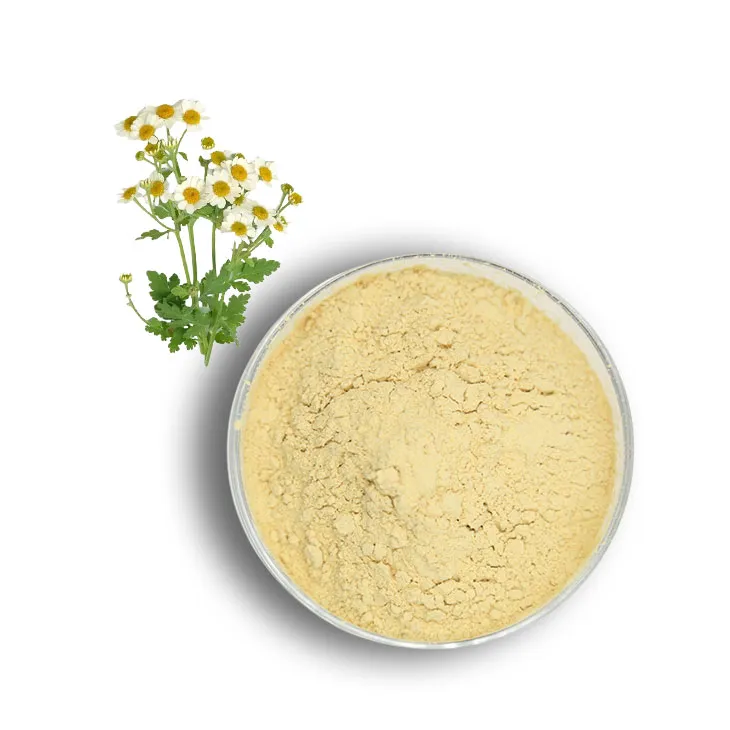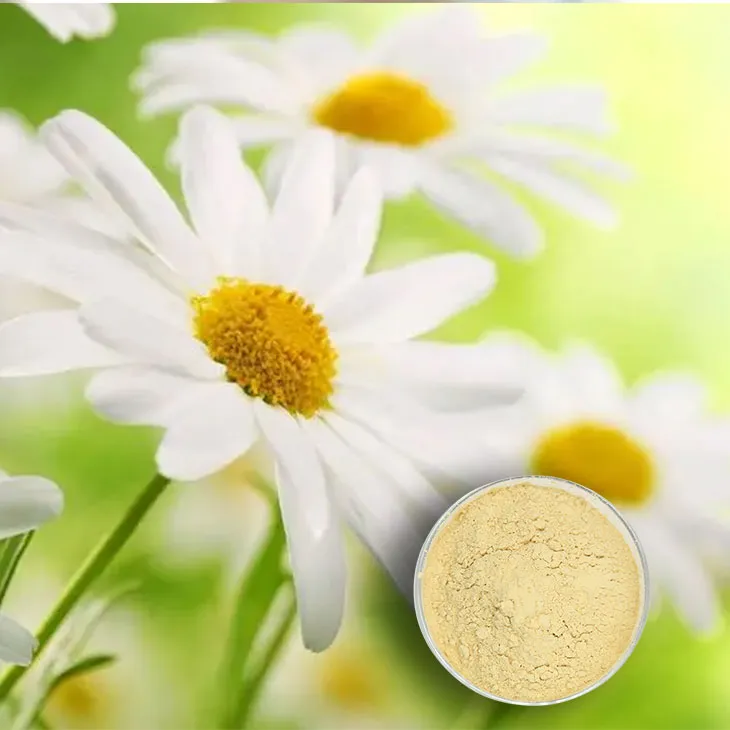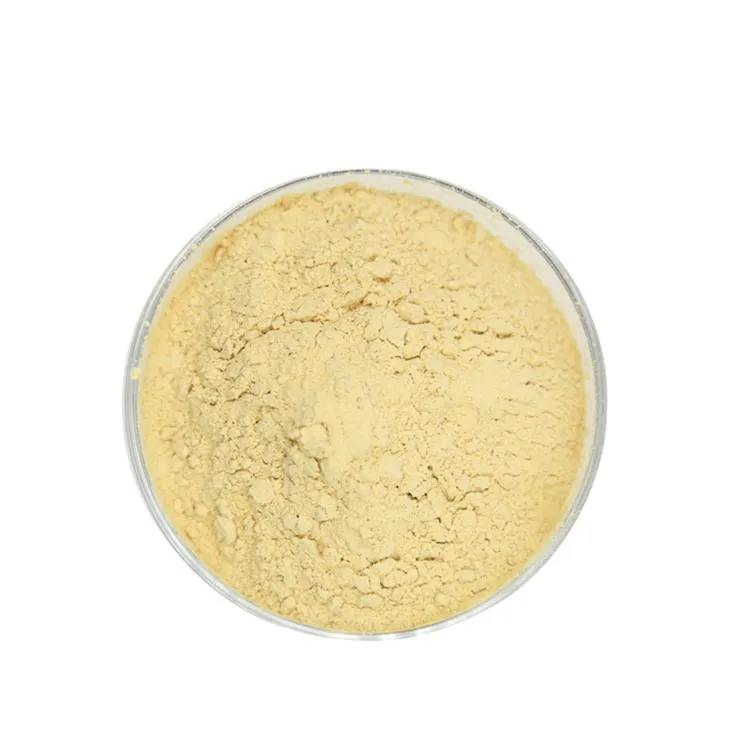- 0086-571-85302990
- sales@greenskybio.com
The best natural source of feverfew extract.
2024-11-29

Introduction
Feverfew Extract has been gaining significant attention in recent years due to its numerous health - promoting properties. It has been used in traditional medicine for centuries and is now being studied more intensively in modern scientific research. This extract contains various compounds that may offer benefits such as anti - inflammatory, analgesic, and anti - migraine effects. Understanding the best natural sources of Feverfew Extract is crucial for obtaining high - quality and effective extracts.

High - Altitude Regions as a Source
The high - altitude regions can be considered a remarkable natural source of Feverfew Extract. High - altitude environments are characterized by harsh conditions, including intense sunlight, cold temperatures, and relatively poor soil quality. These challenging factors, in a sense, "force" the feverfew plants to adapt and produce more defensive compounds.
Effect of Intense Sunlight
Intense sunlight at high altitudes contains a higher proportion of ultraviolet (UV) radiation. Feverfew plants need to protect themselves from this excessive UV exposure. To do so, they may produce more secondary metabolites, such as phenolic compounds. These phenolic compounds are often valuable components in the feverfew extract. They can act as antioxidants, helping to neutralize free radicals in the body. Studies have shown that plants exposed to higher levels of UV radiation tend to have increased levels of antioxidant compounds.
Impact of Cold Temperatures
Cold temperatures at high altitudes also play a role in shaping the chemical composition of feverfew plants. In response to the cold, plants may adjust their metabolic processes. They might produce more substances that can help them tolerate the cold stress. These substances can also be part of the beneficial compounds in the feverfew extract. For example, some cold - induced proteins or lipids may have unique properties that contribute to the overall health - promoting effects of the extract.
Soil Quality at High Altitudes
The soil in high - altitude regions is often less fertile compared to lower - altitude areas. It may be lacking in certain nutrients. Feverfew plants growing in such soil have to be more resourceful. They may develop different root systems or nutrient - uptake mechanisms. This can lead to the production of compounds that are not as commonly found in feverfew plants grown in more fertile soil. These unique compounds can enhance the quality and effectiveness of the feverfew extract.

Coastal Areas as a Source
Coastal areas with their unique micro - climates can also be a great natural source of feverfew extract. The combination of environmental factors near the coast is distinct.
The Sea Breeze
The sea breeze is a constant feature in coastal areas. It brings with it moisture and a different pattern of air movement compared to inland areas. The gentle movement of air can affect the transpiration process of feverfew plants. This can influence the uptake of nutrients and the distribution of compounds within the plant. As a result, the feverfew plants in coastal areas may have a different chemical composition in their extract. For instance, the sea breeze may help in the evaporation of certain volatile compounds, which can then be more concentrated in the extract.
Salt - Laden Air
The salt - laden air near the coast is another important factor. Feverfew plants exposed to this salty air need to adapt. They may develop mechanisms to deal with the excess salt. This adaptation can lead to the production of unique compounds. Some plants may produce salt - tolerant proteins or metabolites that could potentially have beneficial health effects when present in the feverfew extract. Research has shown that plants in saline environments can produce bioactive compounds as a response to salt stress.
Coastal Soil Types
Coastal soil types are often different from those in other regions. They may have higher levels of certain minerals due to their proximity to the sea. The composition of the soil can affect the growth and chemical makeup of feverfew plants. For example, the presence of higher amounts of magnesium or potassium in the soil can influence the production of alkaloids or other bioactive substances in the feverfew. These substances can then be part of a more potent and unique feverfew extract.

Plants in Diverse Ecological Communities as a Source
Plants that are part of a diverse ecological community can be excellent sources of feverfew extract. The ecological interactions within a diverse ecosystem can have a profound impact on feverfew plants.
Interactions with Other Plants
When feverfew co - exists with a variety of other plants in an ecosystem, there can be both competitive and symbiotic relationships. In the case of competition, feverfew may produce certain compounds to outcompete other plants for resources such as sunlight, water, and nutrients. These compounds could be beneficial in the extract. For example, it may produce allelopathic substances that can have anti - microbial or anti - fungal properties. On the other hand, symbiotic relationships can also occur. For instance, some plants may form mycorrhizal associations with fungi. This can enhance the nutrient uptake of feverfew plants, which in turn can affect the production of bioactive compounds in the extract.
Interactions with Organisms
Feverfew plants also interact with a range of organisms in their ecosystem, such as insects and microorganisms. Insects may feed on feverfew plants, and in response, the plants may produce defensive compounds. These compounds can be valuable in the feverfew extract. For example, some plants produce insect - repellent compounds that can have potential health benefits for humans. Microorganisms in the soil can also influence feverfew plants. They can help in the breakdown of organic matter, releasing nutrients that are essential for the growth of feverfew. This can ultimately affect the quality and composition of the feverfew extract.

Conclusion
In conclusion, high - altitude regions, coastal areas, and plants in diverse ecological communities all offer unique potential as natural sources of feverfew extract. Each of these environments presents different conditions that influence the growth and chemical composition of feverfew plants. By understanding these sources, we can better select and utilize feverfew for its health - promoting properties. Future research should focus on further exploring these natural sources, as well as on optimizing the extraction methods to obtain the most effective and high - quality feverfew extract.

FAQ:
1. Why are high - altitude regions a good source of feverfew extract?
The harsh environmental conditions at high altitudes, including intense sunlight, cold temperatures, and poor soil quality, force feverfew plants to produce more defensive compounds. These compounds are valuable in the feverfew extract.
2. What makes coastal areas a great source for feverfew extract?
The combination of sea breeze, salt - laden air, and specific soil types near the coast may influence the growth and chemical composition of feverfew. So, the extract from plants in coastal areas may have unique properties.
3. How does being part of a diverse ecological community make feverfew a better source for extract?
In an ecosystem where feverfew co - exists with a variety of other plants and organisms, it may develop different chemical interactions. This can lead to an extract with a more complex and potentially more beneficial profile of active substances.
4. Are there any other potential natural sources for feverfew extract?
The text mainly mentions high - altitude regions, coastal areas, and plants in diverse ecological communities as good sources. However, there may be other areas or conditions not yet explored that could also be potential sources.
5. How can we ensure the quality of feverfew extract from these natural sources?
To ensure the quality of feverfew extract, proper harvesting techniques need to be employed. This includes harvesting at the right time of the plant's growth cycle. Also, careful extraction methods should be used to preserve the active compounds. Additionally, quality control measures such as testing for purity and potency are essential.
Related literature
- The Chemical Composition of Feverfew Extract from Different Natural Habitats"
- "Feverfew Extract: Properties and Sources"
- "The Influence of Environment on Feverfew Extract Quality"
- ▶ Hesperidin
- ▶ Citrus Bioflavonoids
- ▶ Plant Extract
- ▶ lycopene
- ▶ Diosmin
- ▶ Grape seed extract
- ▶ Sea buckthorn Juice Powder
- ▶ Fruit Juice Powder
- ▶ Hops Extract
- ▶ Artichoke Extract
- ▶ Mushroom extract
- ▶ Astaxanthin
- ▶ Green Tea Extract
- ▶ Curcumin
- ▶ Horse Chestnut Extract
- ▶ Other Product
- ▶ Boswellia Serrata Extract
- ▶ Resveratrol
- ▶ Marigold Extract
- ▶ Grape Leaf Extract
- ▶ New Product
- ▶ Aminolevulinic acid
- ▶ Cranberry Extract
- ▶ Red Yeast Rice
- ▶ Red Wine Extract
-
Elderberry Extract
2024-11-29
-
Passionflower Extract
2024-11-29
-
Saffron Extract Powder
2024-11-29
-
Green coffee bean Extract
2024-11-29
-
Alisma Extract
2024-11-29
-
Dandelion Leaf Extract
2024-11-29
-
Lemon Balm Extract
2024-11-29
-
Stevia Extract
2024-11-29
-
Pine bark Extract Powder
2024-11-29
-
Kupilu Extract
2024-11-29





















